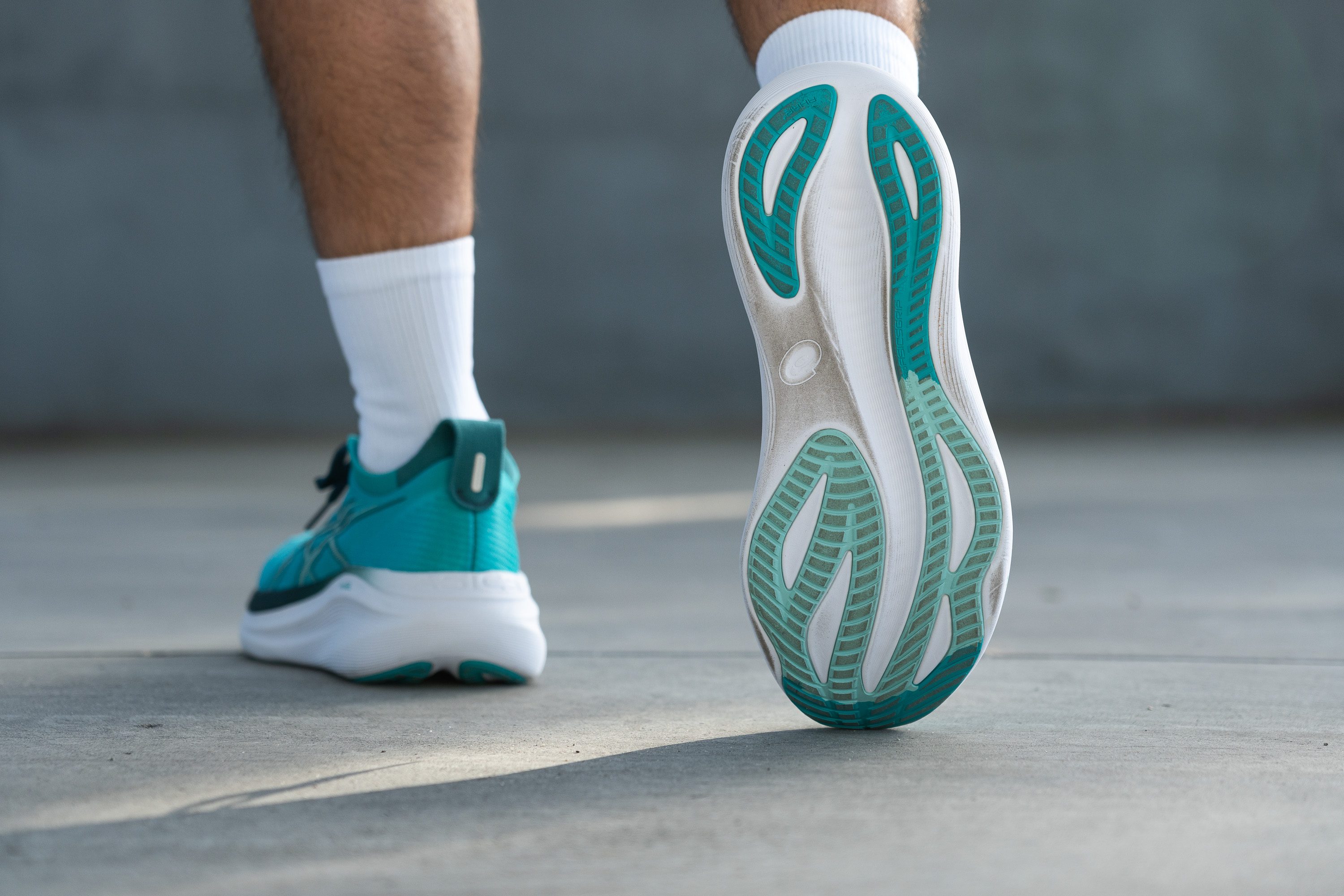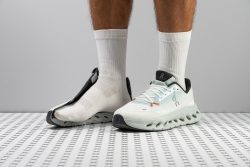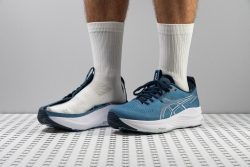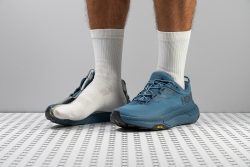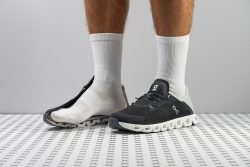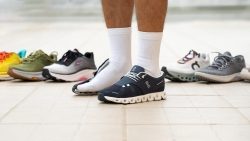7 Walking Shoes With The Best Traction in 2025

We buy shoes ourselves. We earn commissions when you buy through us, at no extra cost. Why trust us
Wet concrete, smooth subway tiles, and slick cobblestone can all become slipping hazards if you are wearing the wrong pair of walking shoes.
That’s why we take outsole traction seriously at RunRepeat and follow a scientifically acclaimed SATRA TM144 method for testing grip on each walking shoe in our catalogue.
See our top picks below and scroll down for more detailed information on walking shoes with the best traction.
How we test Walking shoes with the traction
Equipped with a specialised traction testing machine, we record each walking shoe’s coefficient of friction on wet concrete. These measurements indicate whether a shoe is indeed slip-resistant, reliable on wet surfaces, or only suitable for dry ones.
Aside from that, we perform dozens of other tests and measurements to assess essential shoe parameters, such as durability, cushioning, and fit, among others. This enables us to write the most comprehensive shoe reviews to help you make the most informed decision.
None of our lab tests are influenced by the brands because we buy all the tested shoes with our own money.
Best overall walking shoes with high traction
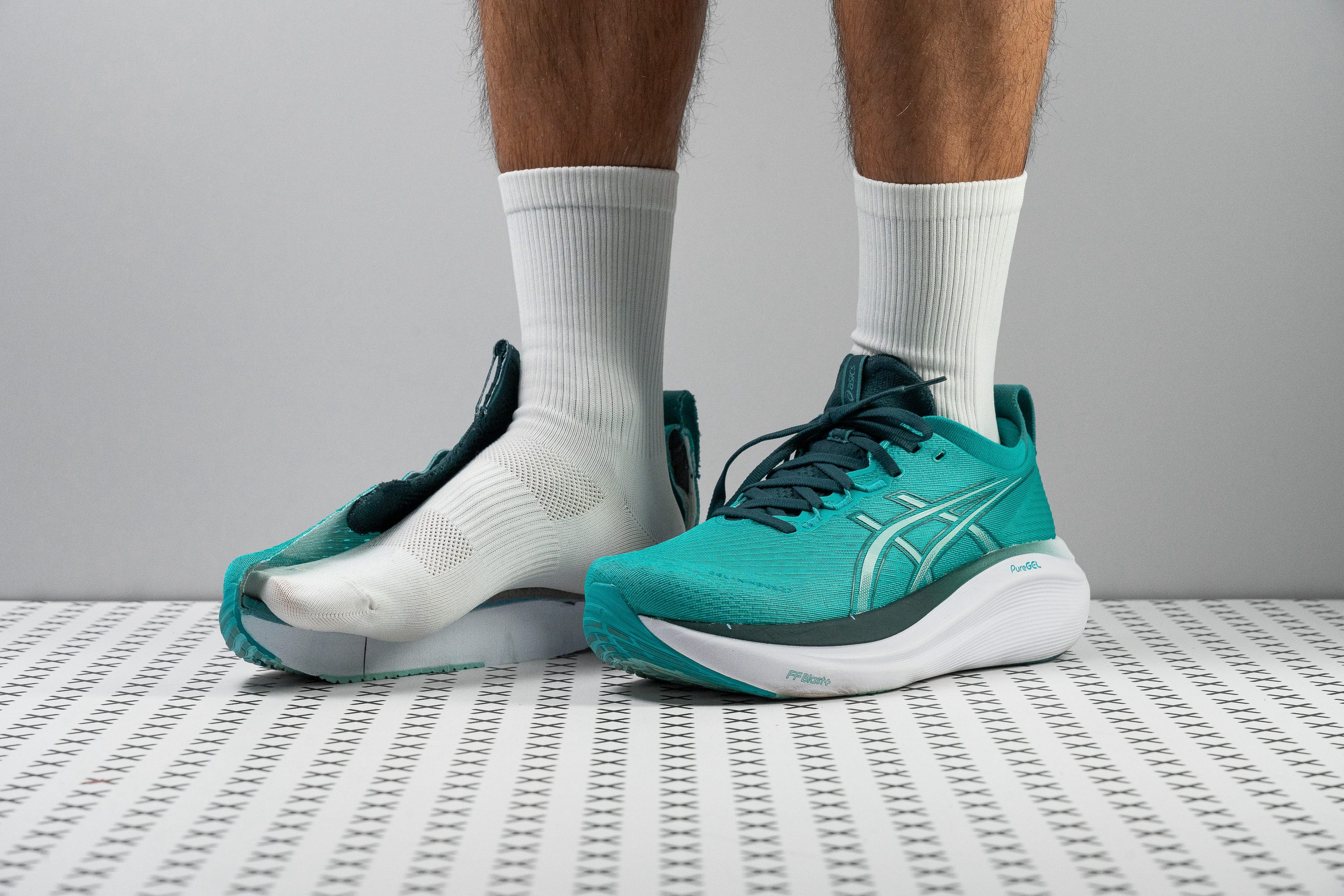


















































What makes it the best?
The ASICS Gel Nimbus 27 is joint-friendly through its abundant cushioning and enhanced, slip-resistant control. Lab results show it combines the unwavering grip of Hybrid ASICSGRIP rubber with its wide and stable base to keep us in control of our footing. We could walk around mindlessly all day with its exceptional combination of support and comfort, making it our best high-traction walking shoe.
In our wet-condition test, we recorded a strong friction score of 0.84. Gel Nimbus 27 earned one of the highest ratings we’ve seen and shows 78.7% stronger traction than average! Whether dealing with rainy sidewalks or smooth tiles, the outsole keeps a strong hold of our footing.
Gel Nimbus 27 suits its name with its skyscraper 42.7/34.4 mm stack. Besides its bottomless cushioning, the foam itself reduces impact 22.5% better than average with its strong 136 SA score in our shock absorption test.
Despite its height and softness, the wide base and sidewalls boost our surefootedness. Our calliper reveals a massive 119.5/99.8 mm platform, explaining why each touchdown feels steady and secure.
However, its bulky midsole comes at the expense of flexibility. Gel Nimbus 27 feels slightly stiffer than we’d hope, so we can’t recommend it to people who prefer a natural underfoot sensation.
Pros
- Even more foam underfoot!
- Premium-feel, breathable upper
- Fantastic stability
- Improved toebox with extra wiggle room
- Flexible knit tongue
- True maximalist comfort for recovery runs
- Amazing heel lockdown
- Top-tier grip
- Top-tier grip
Cons
- Feels bulky and heavy
- Minor price increase
- Lacks energy return
- Minimal outsole coverage
Best slip-resistant walking shoes with high traction
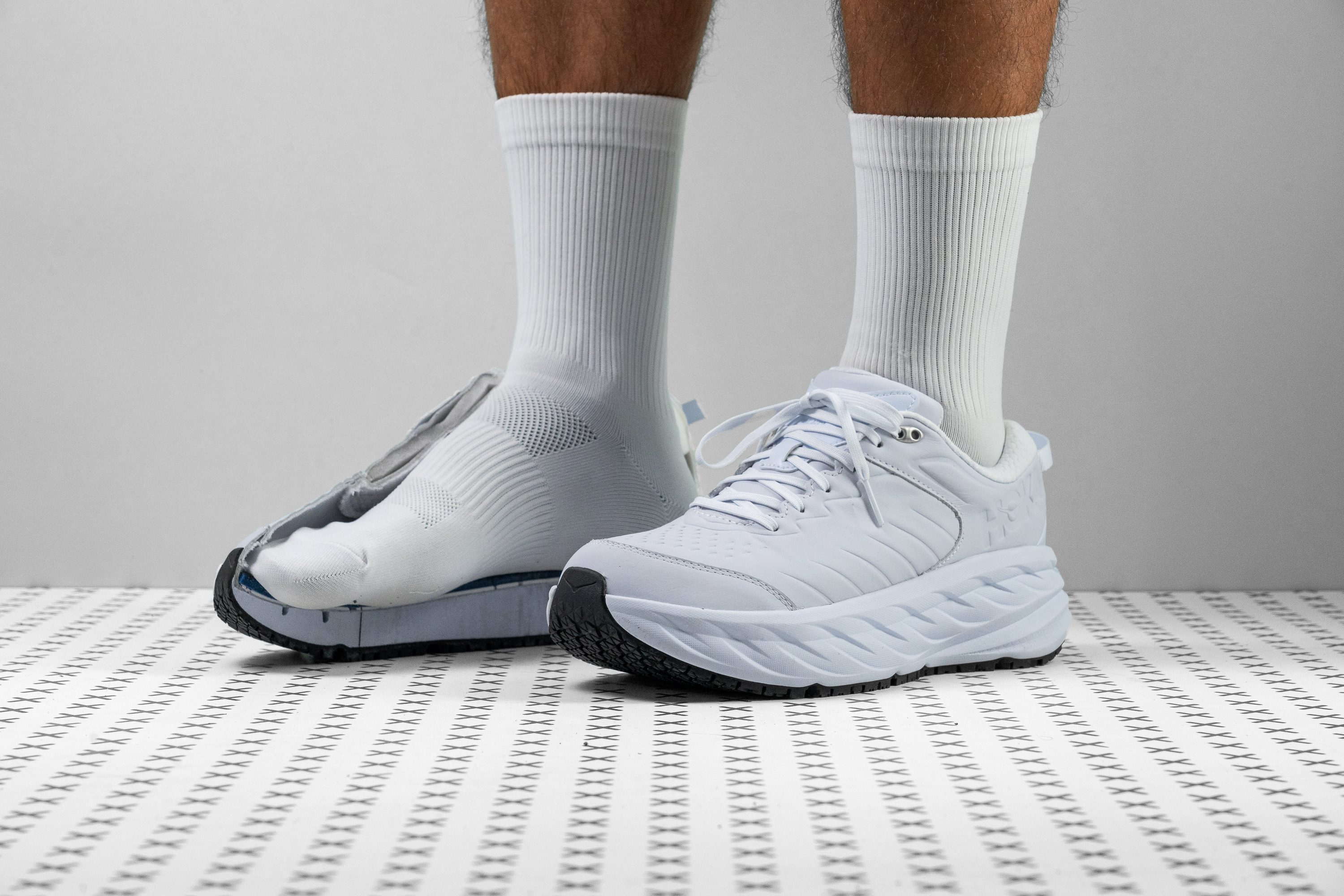










































What makes it the best?
The Hoka Bondi SR offers enhanced control and surefootedness through its superior grip and wide, stable base. It features a monstrous cushion that takes care of our feet, making it a comfortable place to be in during long shifts of walking and standing. Through wear and lab tests, we back up the SR in its name, as it is our best slip-resistant, high-traction walking shoe.
Whether we deal with spilled water on the kitchen floor or inclined snowy streets, the Bondi SR was locked in and did not yield to slips. Our traction test shows an elite score of 0.77, making it a mind-blowing 67.4% grippier than average! Our lab result cements its title with zero doubts.
The Bondi SR has generous rubber coverage due to its massive 124.1/102.2 mm base. It’s one of the widest we’ve ever measured in the lab! Besides extensive rubber to grip the ground, it also allows us to find our footing well so that we don’t lose our balance.
The midsole offers strong all-day support with its generous 39.4/31.2 mm cushioning. With so much foam beneath our feet, we could spend long hours on foot without feeling too tired.
With traction as its priority, the outsole has a higher risk of premature wear. It showed its vulnerability in our Dremel test when it got damaged 148.0% more than average.
Pros
- Comfort is off-the-charts
- Extra thick cushioning for all-day support
- Smooth heel-to-toe transitions
- Alleviates foot discomfort (podiatrist approved)
- Stable for a neutral shoe
- Truly slip-resistant outsole
- Superior material quality
- Water-resistant leather upper
- Accommodating toebox
Cons
- Heavy and bulky
- Not breathable
Best walking shoes with high traction for all-day wear
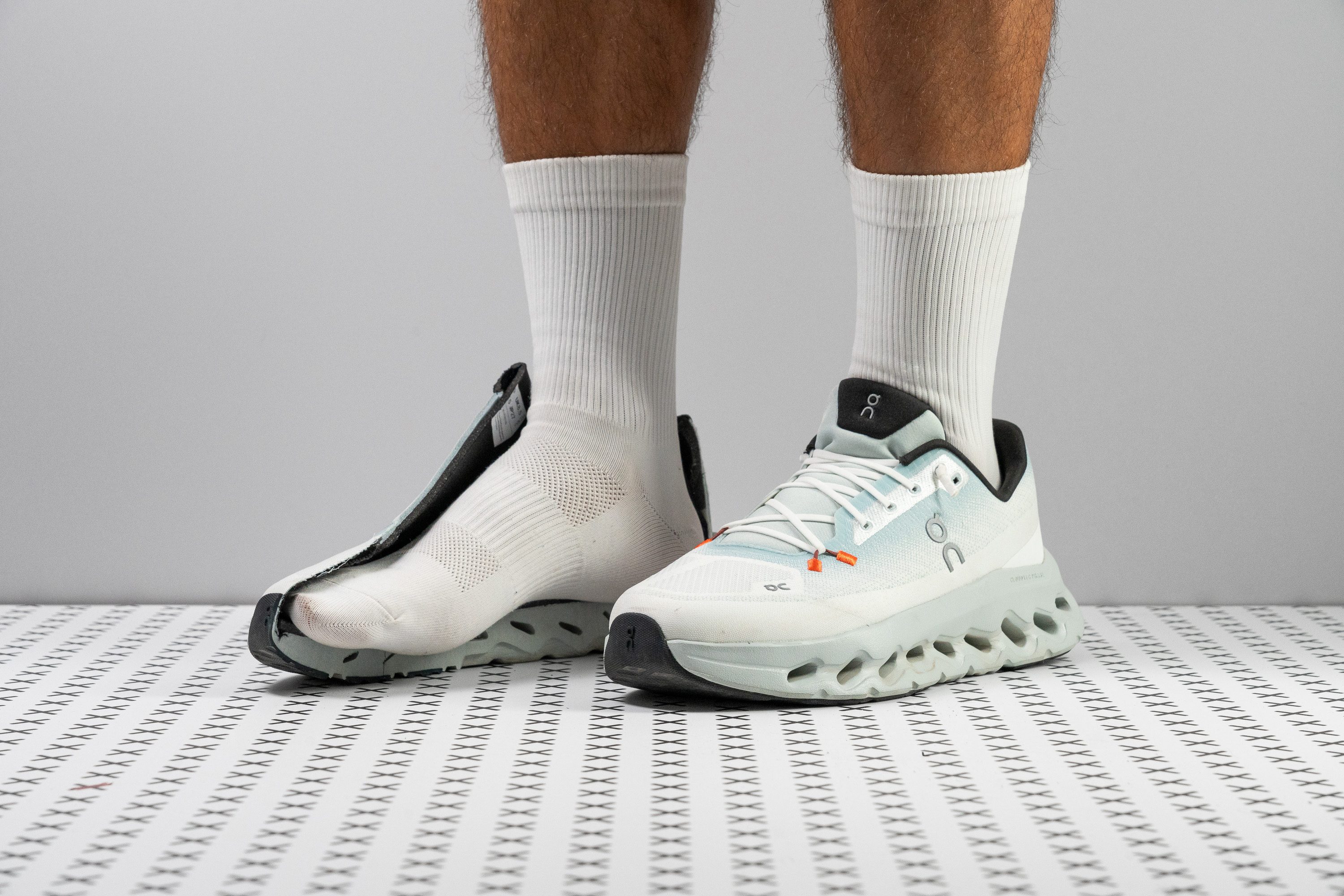























































What makes it the best?
The On Cloudtilt keeps fatigue at bay through premium cushioning in a lightweight frame. Lab evaluations reveal its generous height and strong shock absorption in the midsole, while its outsole hits the sweet spot, offering both reliable traction and durability. Ultimately, it’s perfect for all-day wear among high-traction walking shoes.
Cloudtilt carries its name well, with a minimal build that makes us feel like gliding. Its light 9.4 oz (266 g) build makes hitting our daily step count effortless, moving naturally with our feet.
Cloudtilt feels well-cushioned, and our calliper confirms a generous 35.5/26.8 mm stack height. Besides its foam thickness, it effectively reduces the forces of each landing, offering a gentler experience to our muscles and joints. In our shock absorption test, it excelled with a strong 132 SA score, 18.9% above average. The CloudTec technology also enhances the overall sensation of the shoe with softness and bounce.
The outsole shows superior performance in our lab tests, proving it offers the best of both worlds. In our traction test, we recorded a highly reliable 0.47 score. Meanwhile, our Dremel shorn off 57.1% less rubber than average, proving it will last longer.
Unfortunately, the thick fabric in the upper limits Cloudtilt’s ventilation. Therefore, we cannot recommend prolonged wear in hot and humid weather.
Pros
- Plenty of cushioning for long hours on feet
- Soft yet bouncy ride
- Feels nice and light on foot
- Abrasion-resistant upper and outsole
- Wide and steady platform
- Excellent outsole grip
- Easy on-and-off with bungee laces
- Upper made of recycled material
Cons
- Not very breathable
- Flimsy inner lining and insole
- Not for wide feet
Best stability walking shoes with high traction














































What makes it the best?
Delivering both unwavering support and grip in our strolls, the ASICS Gel Kayano 32 instantly rose to the top of our list as the best stability high-traction walking shoe. Further lab evaluations show it features the 4D Guidance System and a broad base, which helps guide our foot alignment. Its superb traction offers more control, while its strong impact protection keeps fatigue away.
The 4D Guidance System offers effective arch support in the midfoot area, with built-in sidewalls to help centre the ride. The platform is ultra-wide at 119.8/97.2 mm, ensuring we maintain our balance. The midsole is highly twist-resistant, proven by its maximum 5/5 torsional rigidity rating.
GK32 is proof that stability shoes can offer plush comfort. We confirmed its cloud-like touch when we recorded a high shock absorption score of 133 SA in the heel, cushioning our landings significantly compared to the 111 SA average walking shoe.
We assessed the Hybrid ASICSGRIP rubber in our traction test, and it skyrocketed to 0.84, one of the highest we’ve seen in the lab! At this level, it’s a mind-boggling 78.7% gripper than average! No room for doubt, we can confidently handle slippery tiles.
Amazingly, the outsole shows strong performance in our durability test, which is why we would’ve appreciated a thinner outsole to make the shoe less bottom-heavy. While the average rubber is 3.2 mm, GK32’s is 4.5 mm!
Pros
- Amazing shock absorption
- Plush and breathable upper
- Made to last
- Dependable for most pronators
- Heavy-duty outsole with excellent grip
- Stable as a table
- Pillow-soft heel padding
- Improved fit
- Excellent build quality
Cons
- Not for soft-foam lovers
- Bad energy return
- Overpriced in Europe
Best waterproof walking shoes with high traction
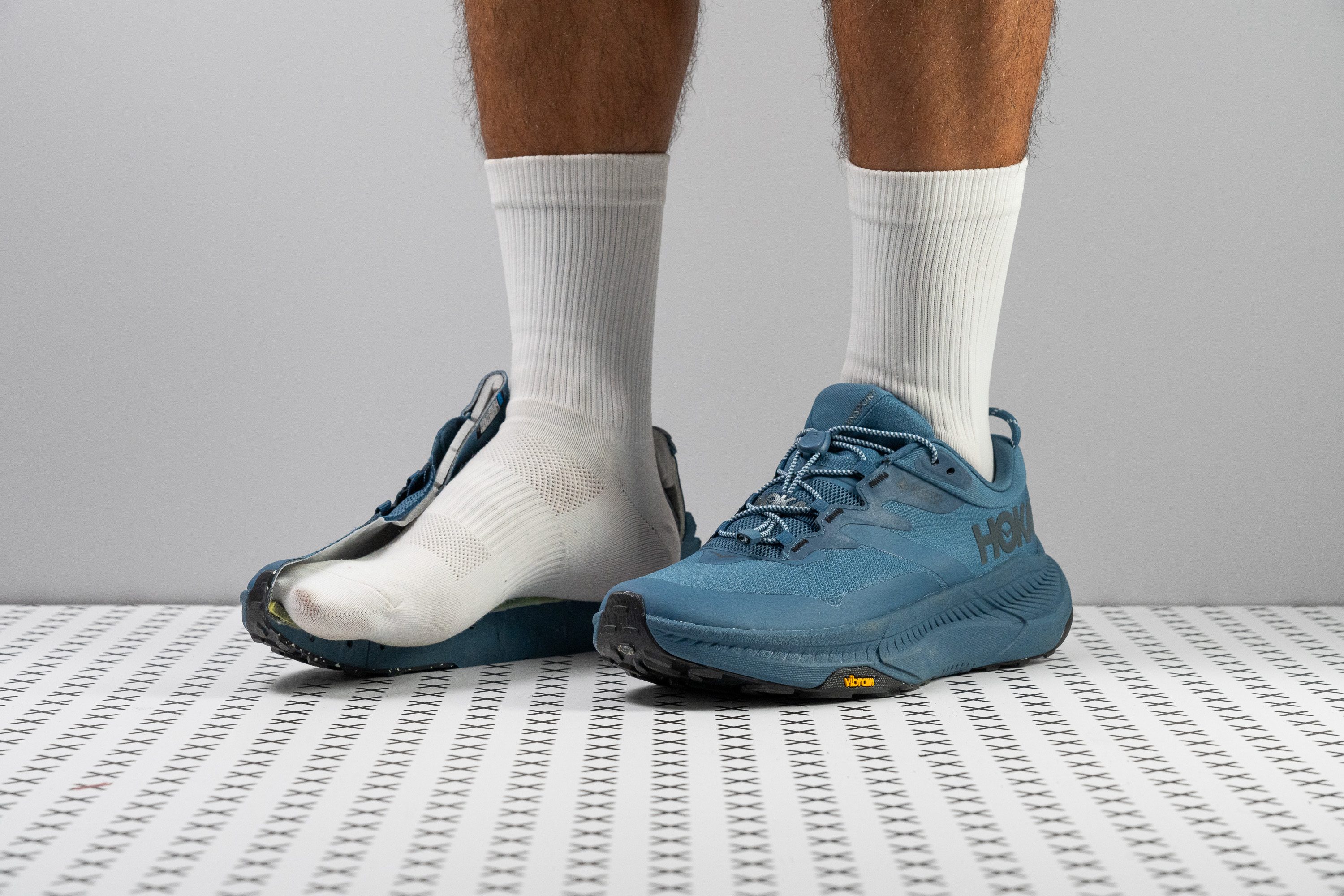






















































What makes it the best?
The Hoka Transport GTX is a reliable shield against harsh conditions, delivering an effective barrier in the upper and a protective, slip-resistant outsole underneath. Whether it’s walking in a sudden downpour of rain or dealing with wet, slippery tiles at work, the Transport GTX kept us dry and safe. We confirmed through lab assessments that it’s the best waterproof pair among high-traction walking shoes.
On top of the Gore-Tex membrane, we discovered a tightly woven and sturdy Cordura upper, which explains why zero smoke could pass through in our breathability test. We awarded it the lowest 1/5 rating, which is good news for waterproof shoes! During testing, our feet remained warm and dry during our encounters with cold and wet conditions.
We strutted the streets with confidence because of the Vibram rubber’s undeniable grip. Testing it using our traction test, it scored a solid 0.56, showing 21.7% stronger bite than average.
Transport GTX is perfect as a daily beater because of the all-around durability it proved in the lab. Our Dremel only damaged the outsole by 1.0 mm compared to the 1.4 mm average. It also exceeded the standard with a solid 4/5 durability rating in both the toebox and heel padding.
However, all the sturdy elements brought its weight down to 11.6 oz (330g). Those seeking a lightweight and agile option should look for alternatives.
Pros
- Top-class waterproofing
- Cushioned and supportive for all-day wear
- Smooth strides thanks to rockered shape
- Very stable platform
- Highly durable construction
- Excellent grip on dry and wet city streets
- Quick and easy lacing system (regular laces included in the box as well)
- Reflective elements all throughout the upper
- Sustainable materials in almost every shoe part
Cons
- A bit heavier than average
- Major stack and drop discrepancy with official specs
- Not for wide feet
Best lightweight walking shoes with high traction






























































What makes it the best?
Pros
- Perfect for travelling
- Incredibly breathable
- Lightweight and flexible structure
- Easy-on and very practical (collapsible heel)
- Quite durable overall
- Reflective elements
- Okay for sockless wear
- 44% recycled materials (upper)
- Perfect for travelling
- Great outsole traction
Cons
- Not for high insteps
- Not supportive
- Not supportive
Best budget walking shoes with high traction




























































What makes it the best?
Pros
- Comfortable and well-padded
- Wonderfully balanced cushioning
- Durable upper materials
- Soft and supportive insole
- Great traction on dry and wet
- Dad-shoe vibes
- Available in 3 widths
- Nice value for money
Cons
- On the heavier side
- Might rub on your heel
- Not for narrow feet
Testing walking shoe traction in our lab
Honouring the SATRA TM144 method for testing shoe outsole grip, we recreate real-life conditions as much as possible when testing shoes in our lab:
- We mount the shoe on a 7-degree wedge because your foot always touches the ground at an angle during a normal walking gait cycle.
- Our machine applies a force of 500N (+/- 25N) to the shoe when pressing it against the testing surface to mimic the impact of the walker’s body weight.
- The machine only slides the shoe’s heel against the testing surface and not the entire sole or the forefoot. Why? Heel landing is the most slip-prone part of the gait cycle. At this point, your body weight isn’t fully transferred onto the foot yet, but your heel is moving forward and downward, which creates a forward shear force and can result in slippage if the shoe’s outsole friction is insufficient.
- The test is performed on a slab of wet concrete because we want to test each shoe in critical conditions.
We repeat the test 10 times for each shoe to eliminate odd and outlying results and record the mean coefficient of friction (CoF). This measurement indicates how much friction is generated between the shoe’s outsole and wet concrete. The higher the number, the better the grip.
Here is an overview of walking shoes that showed the highest friction scores in our grip test:
Wet surface traction and slip-resistance
If you are specifically looking for shoes to walk in slick conditions, like rainy sidewalks, wet stone, or tiles, we highly recommend choosing shoes with a friction coefficient of:
- at least 0.40 if you want good grip
- at least 0.50 if you want a tackier grip to feel more confident
Medical staff, as well as people employed in warehouses, delivery, food, or service industries, will also benefit from shoes with higher traction scores.
But please note that not all shoes that received high friction scores in our grip test carry the slip-resistant badge. Brands that produce slip-resistant walking shoes (HOKA, New Balance, Skechers) may follow different methods and standards of ensuring slip resistance. Aside from SATRA TM144 (which is what we use), shoe companies also follow international and European standards like EN ISO 13287 and ASTM F2913.
However, our grip tests have so far confirmed that shoes positioned as slip-resistant tend to have very high friction scores. For example, the HOKA Bondi SR returned some of the highest measurements with a CoF of 0.77.
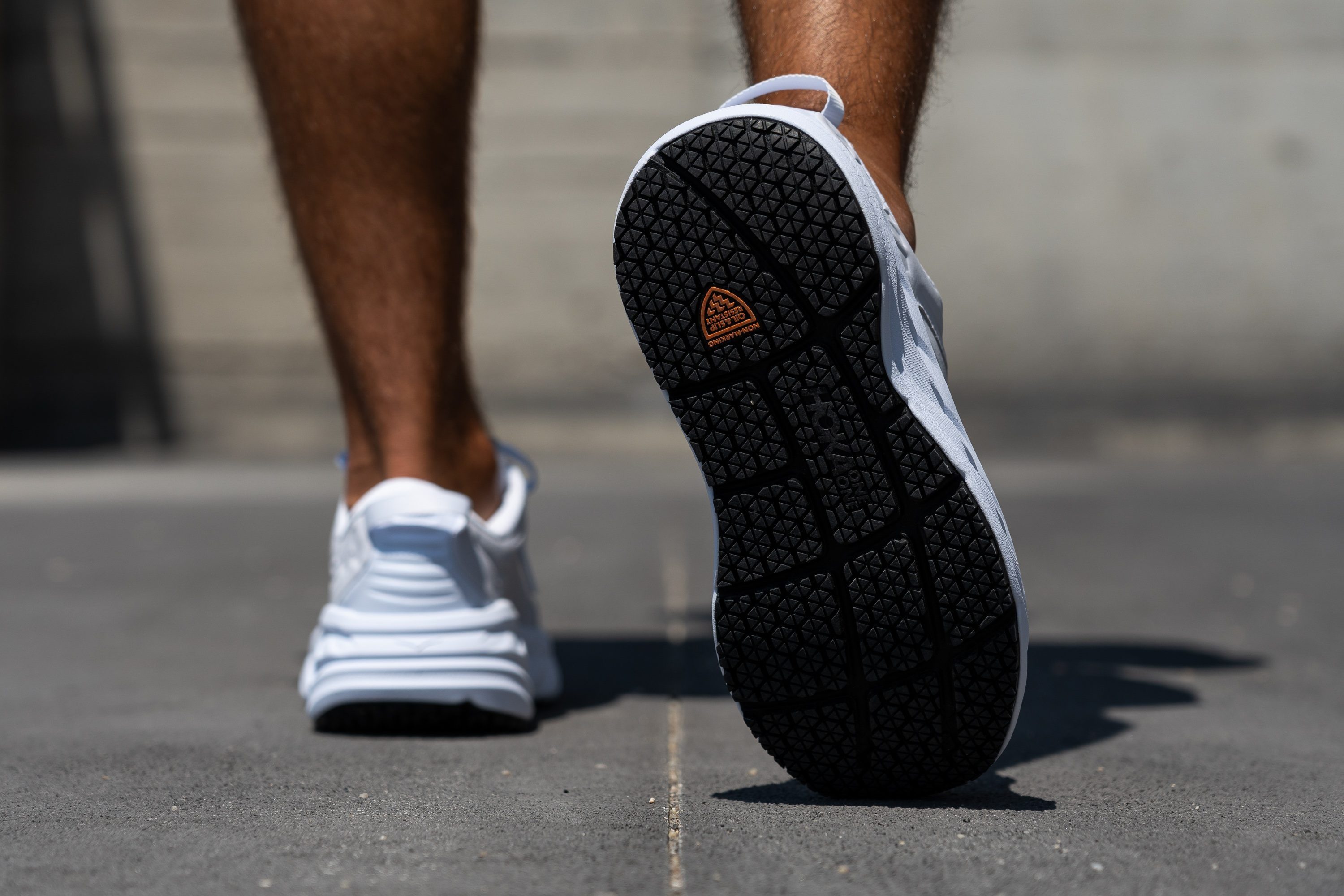
Traction and outsole durability
The initial traction is not guaranteed forever, and there will be an inevitable decline in grip as the shoe’s outsole deteriorates with use. As the rubber smoothes out, it loses the treading, siping, and grippy qualities that generated good friction in the first place.
The degradation happens even faster in shoes that had a lot of exposed foam or no rubber outsole in the first place (many Skechers shoes, for example).

You want to invest in a decently durable walking shoe that will maintain its gripping capacity for an entire season or even more.
We thoroughly test the wear resistance of each walking shoe’s outsole using a Dremel with a sandpaper tip. The latter is applied to one spot on the shoe’s outsole (in the heel area) for 18 seconds at a high speed of 10K RPM and consistent pressure of 2N.
Once the drilling is done, we measure the depth of the dent with a tread gauge - the smaller the number, the sturdier the rubber. Less than 1.5 mm of damage is usually a good sign of durability.
In addition, we cut the shoe in half and measure the thickness of its rubber outsole with a digital calliper. Durable walking shoes will have at least 3 mm of outsole thickness.
Here is an overview of walking shoes with great traction scores for both outsole traction and durability.
Road running shoes for walking on slippery surfaces
Most daily running shoes double as walking shoes without a problem, and this broadens your options of grippy shoes quite significantly!
Unlike running shoes for competition, these daily beaters are lined with a good amount of outsole rubber from the heel to the toes, offering consistent grip, just like walking shoes.
Here are some of the road running shoes that received the highest traction scores in our tests:
